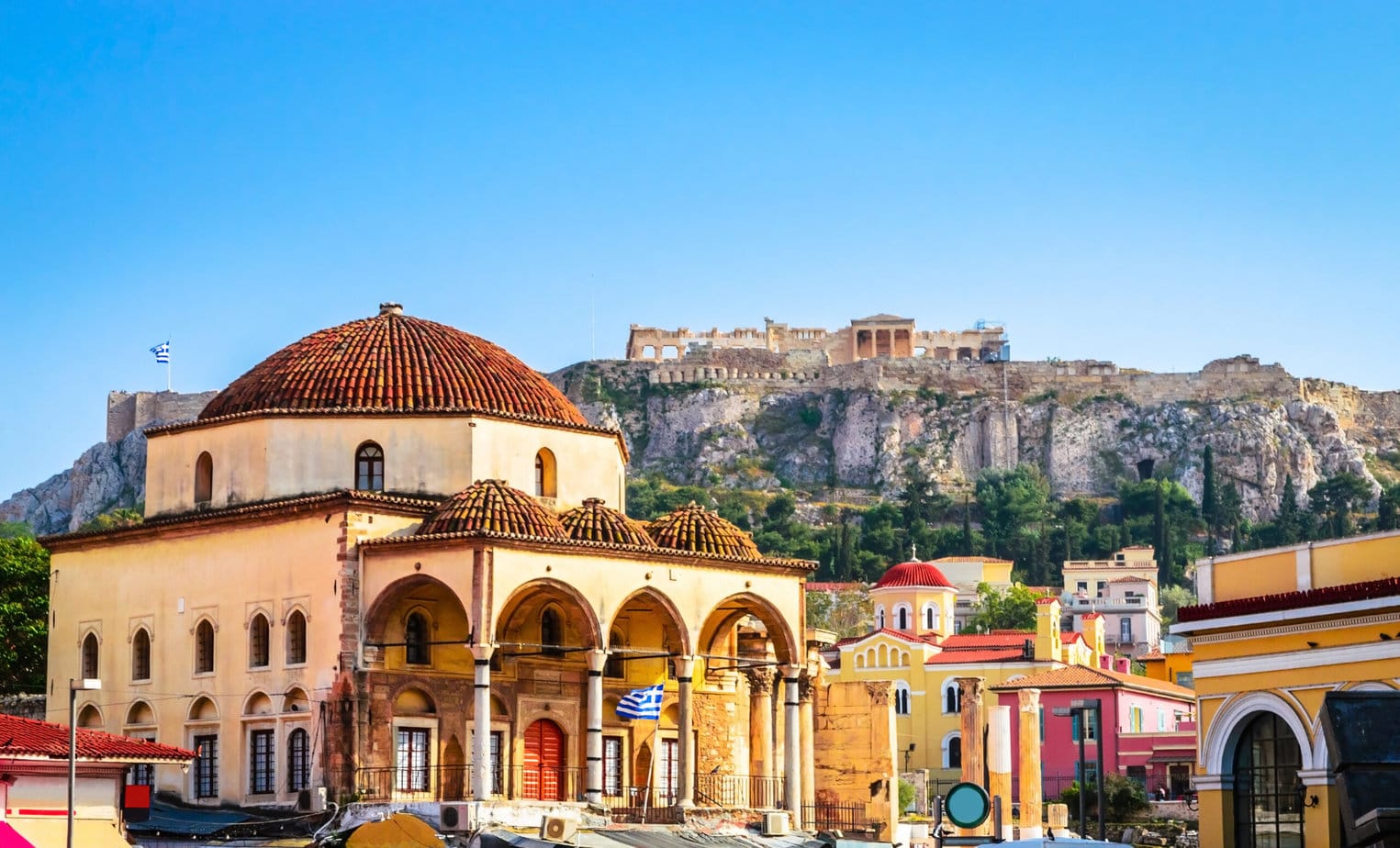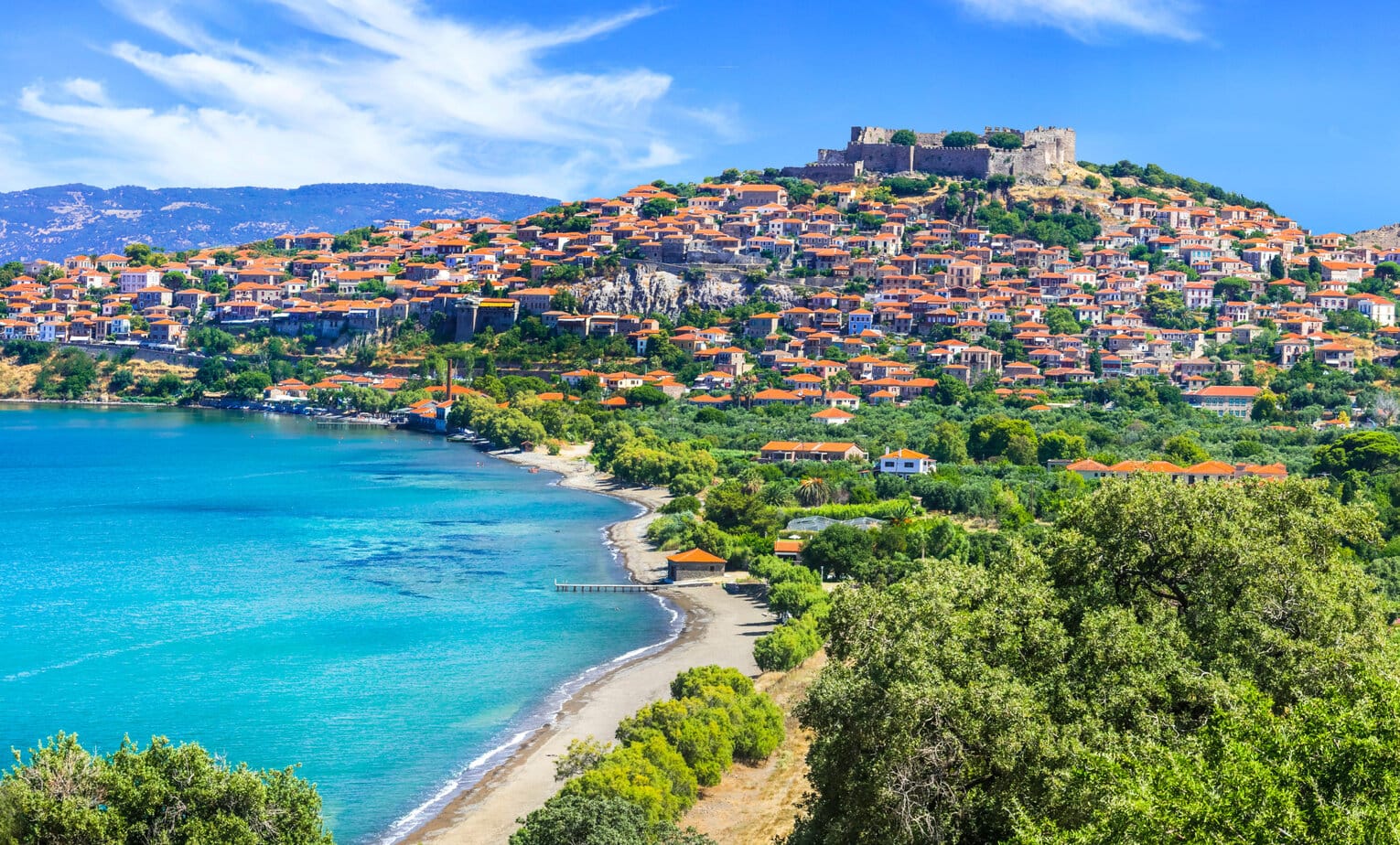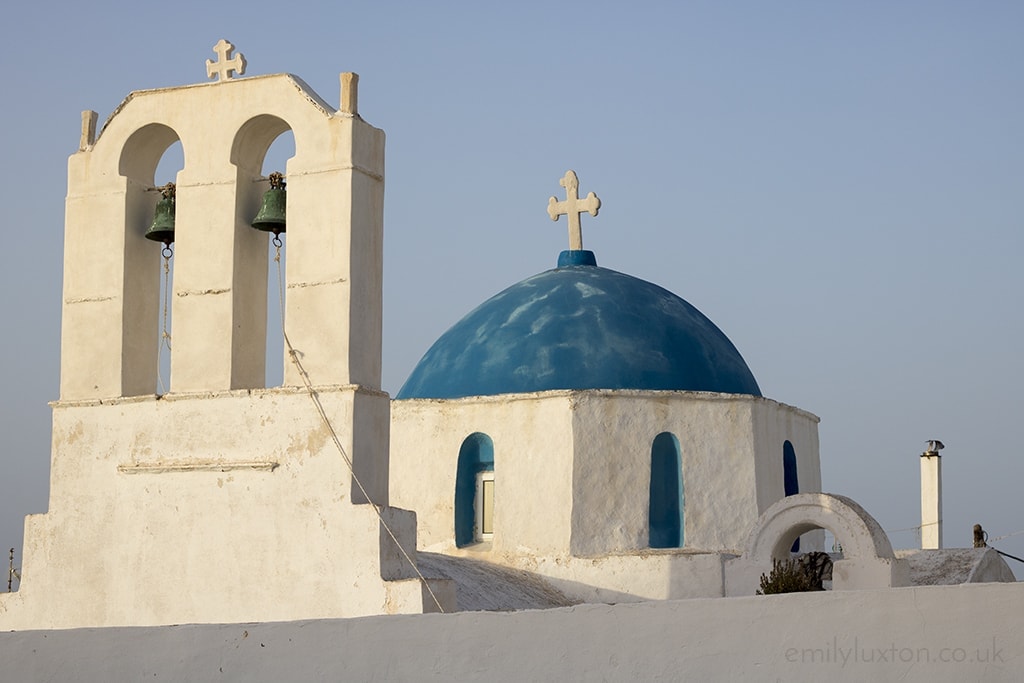Some posts on this site contain affiliate links. If you book or buy something through these links, I earn a small commission (at no extra cost to you). Take a look at my privacy policy for more information.
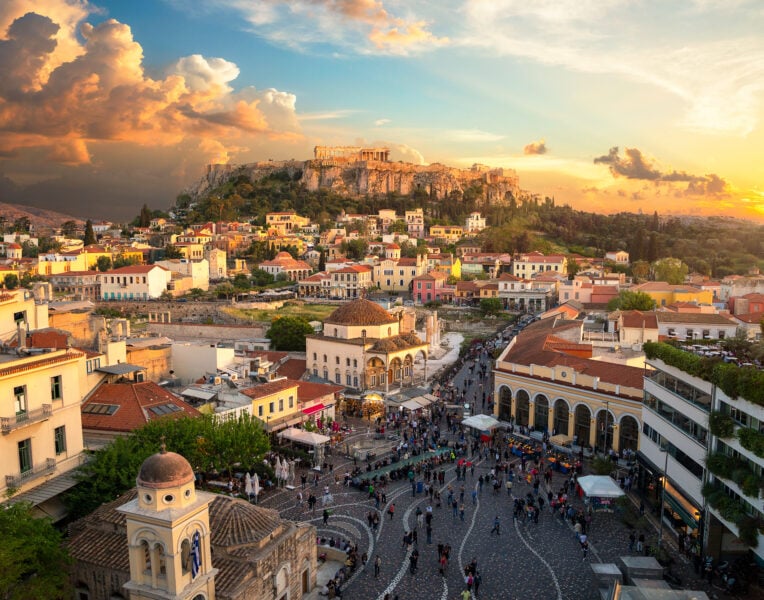
Discover a different side to Athens with these fun, unusual things to do in the Greek capital…
Athens. One of the world’s oldest cities, a place where the ancient world collides with the modern – and where multiple layers of history and culture coexist in a chaotic jumble.
Ancient architecture emerges all over the city centre: visible in metro stations, under public squares, or incorporated into modern buildings. And all the while, the iconic Parthenon on Acropolis Hill overlooks the city’s skyline.
But beyond the history the city is so famous for, Athens is a pulsing and fast-evolving metropolis undergoing a radical urban transformation. Once-impoverished districts are being reclaimed as artistic centres, packed with colourful street art, trendy boutique shops, and bars & restaurants to suit every taste imaginable.
Once you’ve checked off the main attractions in Athens, it’s time to immerse yourself in the city’s numerous personalities. Dive into popular local nightlife hotspots, seek street art between Byzantine buildings, beach-hop your way along the Athens Riviera, or people-watch at the bustling city centre markets.
These are some of the more unusual things to do in Athens – to help you get under the skin of the city and experience it a bit more “like a local”. Don’t have time to read the whole article? There’s also a map and a short version of the list at the bottom of this page. Enjoy…
- Recommended Athens Tours
- Unusual Things to do in Athens
- 1. Don’t Miss the Ancient Sites in Athens
- 2. See Athens with a Local on an Alternative Athens Tour
- 3. Watch the Changing of the Guard at Syntagma Square
- 4. Seek out the Street Art in Athens
- 5. Hunt for Bargains at Monastiraki Flea Market
- 6. Discover Athens’ Contemporary Art Scene at TAF (The Art Foundation)
- 7. Witness Four Eras of Athens History at Monastiraki Square
- 8. Take a Greek Food Tour in Athens
- 9. Discover a Roman Tomb inside a Zara Store
- 10. Swing by the Archaeological Site inside Monastiraki Metro Station
- 11. Spot Neo-Classical Architecture on Panepistimiou Street
- 12. Soak Up Ottoman Architecture and Hipster Vibes in Psirri District
- 13. Learn About the German Occupation at Korai 4
- 14. Dive Into the Trendy Gazi District
- 15. Take a Sip of History at the Oldest Distillery in Athens
- 16. Take an Olympic Work Out in the Historic Stadium
- 17. Watch an Ancient Greek Theater Performance
- 18. Or Catch a Film at an Open Air Cinema in Athens
- 19. Shop with the Locals at Varvakios Market
- 20. Explore the Seafront of the Athens Riviera
- 21. Take a Greek Cooking Class
- Unusual Things to do in Athens: Quicklist and Map
Recommended Athens Tours
Whether you want to explore the main sites in Athens or get off the beaten track, there are some great tours on Get Your Guide. These are some of the top-rated:
Unusual Things to do in Athens
In a hurry? There’s a map and a short version of the list at the bottom of this page! Use the contents menu above to skip ahead if you need to.
1. Don’t Miss the Ancient Sites in Athens
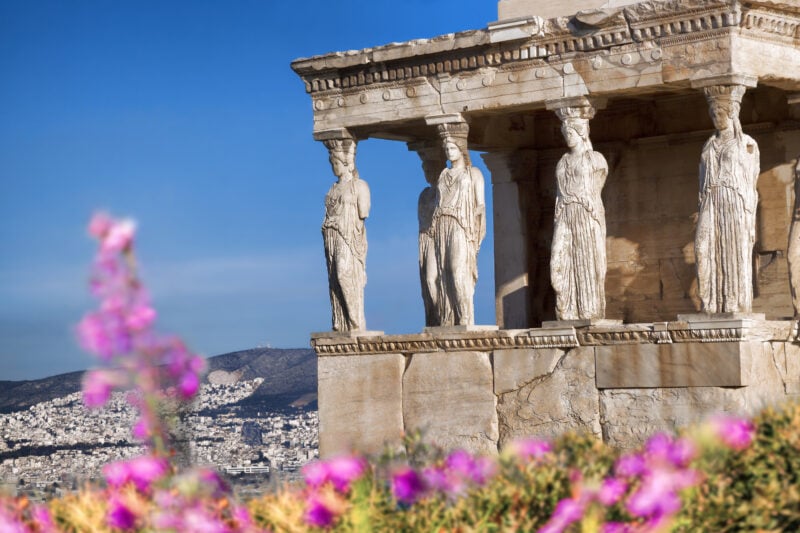
Athens is famous for its ancient sites – especially the iconic, hilltop Acropolis which can be seen from all around the city. These don’t really count as “unusual things to do” as they’re so well known, but they are definitely must-sees when you visit Athens. So here’s a brief list of the “top” ancient sites you shouldn’t miss:
- The Acropolis and the Parthenon. For a more unusual take on Athens’ most famous sight, check out this Acropolis Mythology Tour.
- The Acropolis Museum
- The Ancient Agora
- Odeon of Herodes Atticus
- Temple of Hephaestus
- Panathenaic Stadium
- Top tip – you can buy a Combo Ticket for entry to all of the following: Acropolis, Ancient Agora, Roman Agora, Temple of Zeus, Aristotle’s School, Hadrian’s Library, and Kerameikos Ancient Cemetery. Click here for details and latest prices.
RECOMMENDED TOUR: Acropolis, Parthenon, & Acropolis Museum Guided Tour (from €57pp)
2. See Athens with a Local on an Alternative Athens Tour
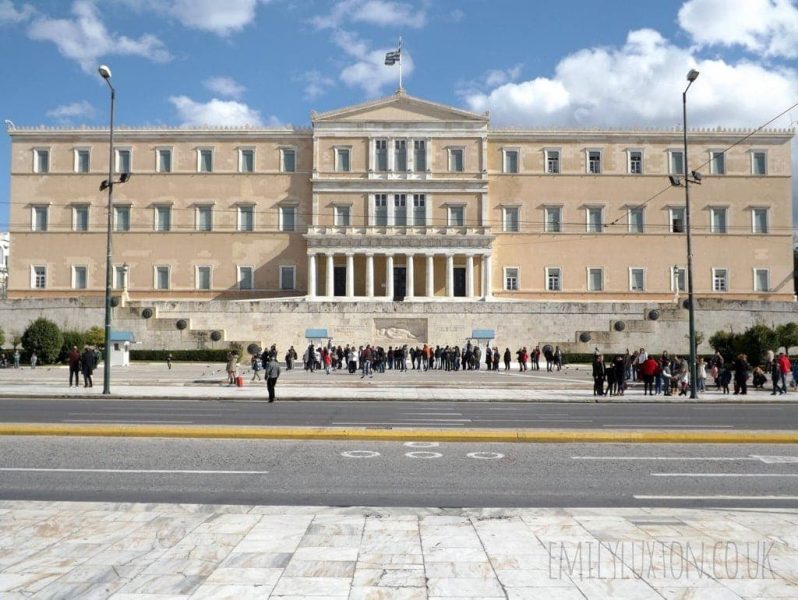
When I visited Athens, I took a walking tour with a fantastic local company called Alternative Athens. They’re easily one of the best tour companies in the city, offering small-group walking tours led by expert local guides – all of which aim to take you beyond the classic tourist sites and help you get to know the real, authentic Athens.
Alternative Athens runs several unique city tours, including food tours, a Gay & Lesbian Nightlife Tour, and a Street Art Tour. I took the Unexpected Athens Orientation Tour, which runs daily at 9:30am, takes four hours, and costs €49 per person.
It’s the perfect introduction to the city, taking in most of the main sites as well as some of the city’s quirkier districts. Plus, your guide will be able to share lots of insider tips for places to eat and drink during your trip to Athens. You just can’t beat a recommendation from a local!
3. Watch the Changing of the Guard at Syntagma Square
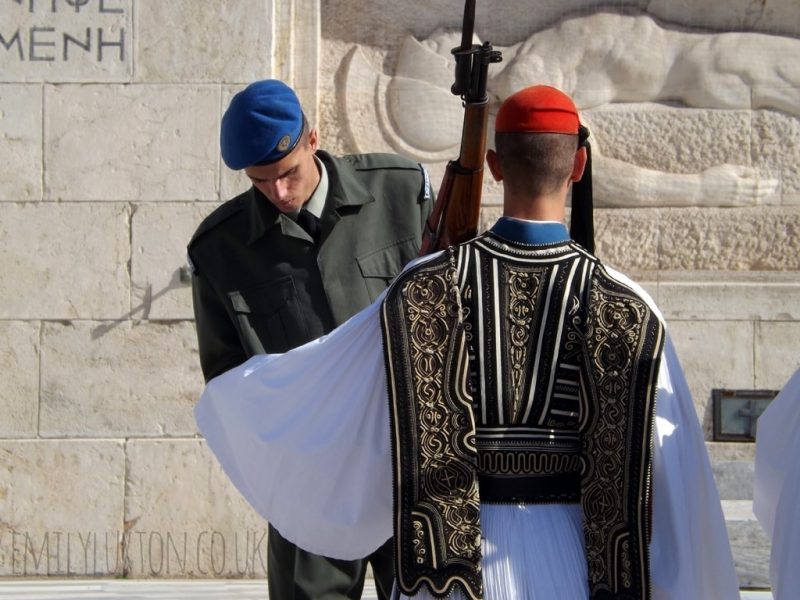
Syntagma Square feels like the heart of Athens: a bustling square at the pinnacle of the busy high street Ermou.
It’s home to the Royal Palace, a modest neo-classical building dating from the 1830s when Greece finally gained independence after centuries of Ottoman occupation. Today, the palace houses the Greek parliament.
Don’t miss the Tomb of the Unknown Soldier in front of the parliament building: a memorial dedicated to the fallen soldiers of Greece’s wars. The tomb is constantly guarded by soldiers dressed in traditional livery, including Tsarouhi: large, clog-like shoes with studded soles and fluffy pompoms on the toes.
The Changing of the Guard takes place every hour, a drawn-out process involving all the pomp and fussiness you’d expect form such a ceremony. It’s free to watch and is well worth including on your Athens itinerary. On Sundays at 11am, the Grand Change takes place: a larger version of the ceremony involving more soldiers and even more pomp!
4. Seek out the Street Art in Athens
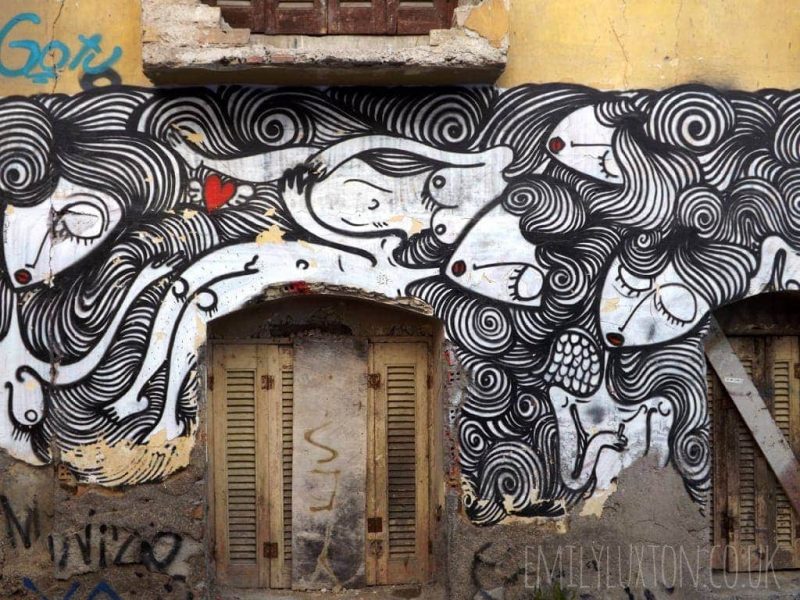
Fans of street art and urban art will love exploring Athens’ historic sidestreets and quirky hipster neighbourhoods. There are murals, installations, and colourful pieces of street art everywhere!
Psirri, Monastiraki, Gazi, and Metaxourgio are some of the best districts to go street art hunting. Better still, take a guided tour with a local expert to help you find the best street art in Athens. I’d recommend one of these two:
- Athens Original Street Art Tour – 3 hours, from €53pp
- Guided Urban Street Art Tour – 2 hours, from €40pp
5. Hunt for Bargains at Monastiraki Flea Market
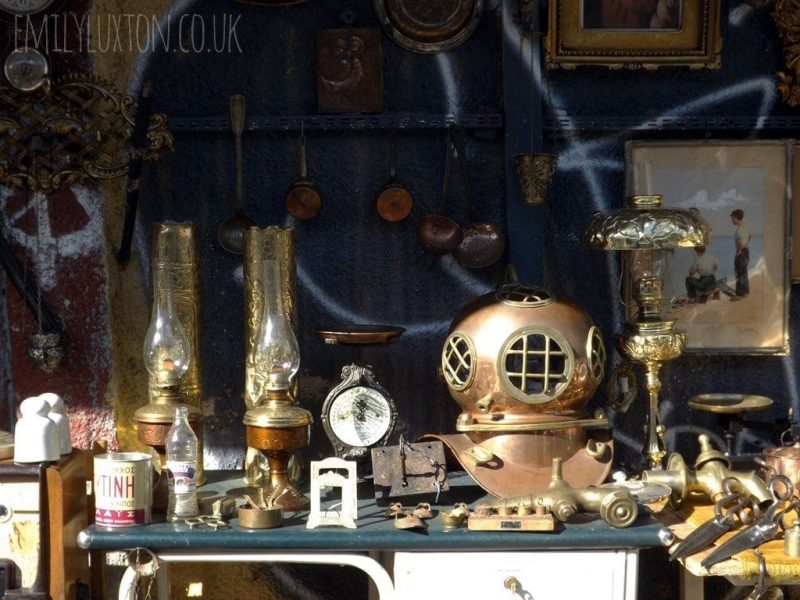
Monastiraki is a historic neighbourhood close to the Ancient Agora known for its quirky shopping scene and colourful street art. The labyrinthine network of narrow streets is crammed with fantastic eateries and bars, artisanal boutiques, and cool vintage shops.
Don’t miss the famous Monastiraki Flea Market. This is held every Sunday morning in the area between Monastiraki Square and Avissynias Square. Stalls here sell everything from broken Barbies and surplus army gear to antique furniture and old coins. There are often street performers and busking musicians, too, giving Sunday mornings a party vibe!
Although the market is only held on Sundays, the whole area is filled with antique shops and unusual boutiques that are open all week. So even if you’re not visiting Athens at the weekend, it’s still worth exploring the Monastiraki Flea Market area for some window shopping, people-watching, and bargain-hunting.
6. Discover Athens’ Contemporary Art Scene at TAF (The Art Foundation)
Housed within a beautifully crumbling Ottoman mansion with a central courtyard, TAF is an innovative cultural centre in Athens’ Monastiraki district. They host international and local group exhibitions, as well as cultural events, workshops, performances, and film screenings.
It’s worth visiting just to explore the building itself – but this cultural hub is also home to a contemporary art gallery, a shop promoting local designers, and a lively courtyard cafe-bar.
7. Witness Four Eras of Athens History at Monastiraki Square
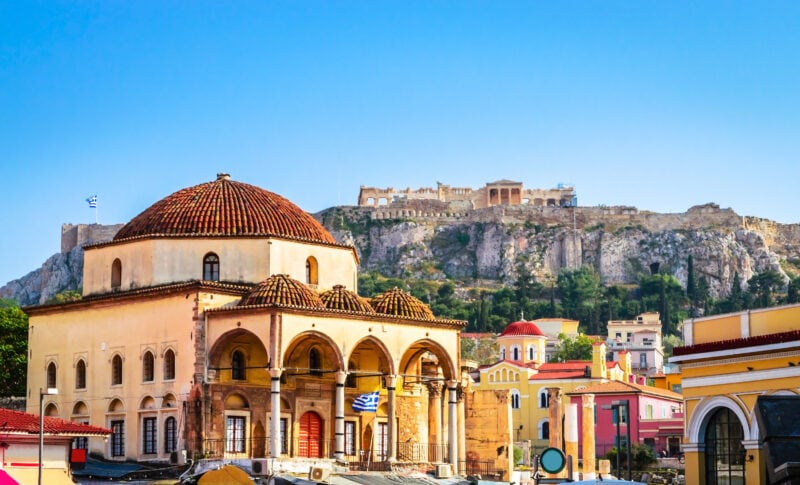
From Athens’ famous Monastiraki Square, you can enjoy a view that takes in the four major eras of the city. There’s the red-tiled dome of the Ottoman Tzisdarakis Mosque, the Roman pillars of Hadrian’s library, the modern metro station, and the Ancient Greek Acropolis above.
It’s a great image to summarise Athens, where the layers of the city’s past are chaotically intertwined creating a complex, colourful mishmash of different eras, architectures, and influences.
8. Take a Greek Food Tour in Athens
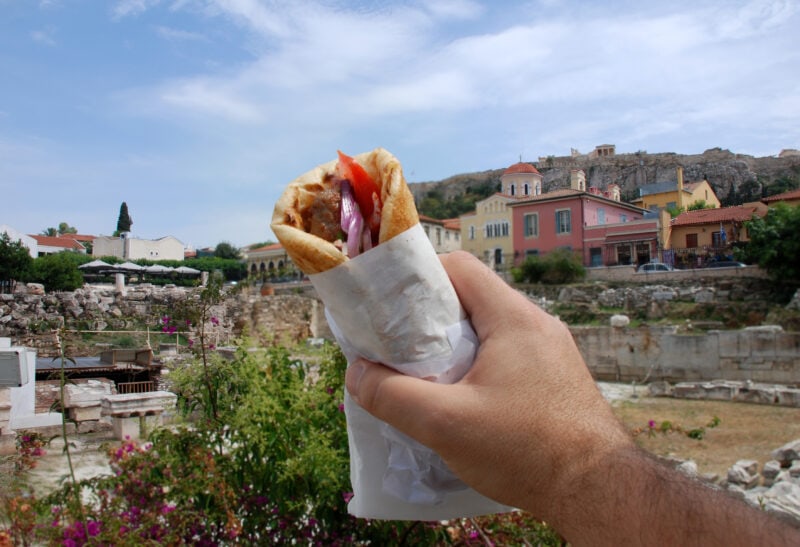
In my opinion, the best way to get to know a culture is through food. I try to take a food tour in every city I visit. It’s the perfect way to explore the local flavours (both literally and figuratively. There are some fantastic food tours in Athens to choose from – these are my top picks:
- The Original Greek Food Tour – 4 hours, from €69pp
- Athens Street Food Tasting Tour – 3 hours, from €52pp
- Classic Food Tasting Tour – 3.5 hours, from €64pp
9. Discover a Roman Tomb inside a Zara Store
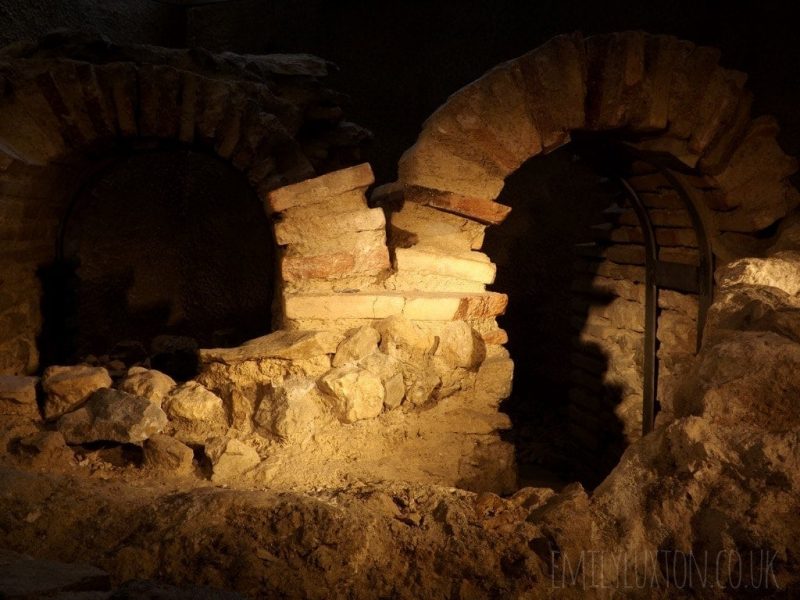
Head to the Zara store on Stadiou Street for a true hidden gem in Athens. On the basement level, you can see the ruins of an Ancient Roman tomb!
These are protected by a glass wall, and have a glass ceiling so you can look down from the floor above as you enter the shop.
Athens is Europe’s oldest capital city, with recorded history dating back over 3,400 years, so there are many traces of the past buried beneath the modern city. It seems you can’t start digging in the centre of Athens without discovering something, and many modern buildings have had to be distorted during building to preserve the past. This is just one of many examples: but it’s free and easy to visit so well worth the detour!
10. Swing by the Archaeological Site inside Monastiraki Metro Station
Leading on from the above, there’s also a small archaeological site inside the Monastiraki Metro Station. Several archaeological finds were uncovered during the station’s construction, dating as far back as the 8th century BC. It’s also free to visit – so stop by before you catch your train!
11. Spot Neo-Classical Architecture on Panepistimiou Street
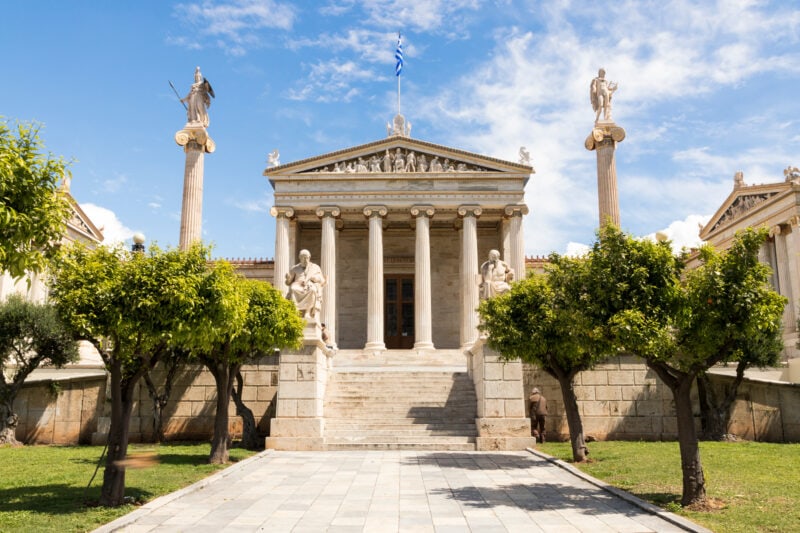
Take a stroll along Panepistimiou Street, a major street running from Omonia Square to Syntagma Square, to find a treasure trove of neoclassical architecture.
The most famous buildings here form the so-called “Neoclassical Trilogy”: the Academy of Athens, the National and Kapodistrian University of Athens, and the National Library. These are considered three of the best pieces of architecture in the city and are absolutely stunning.
There are several more buildings worth noticing along Panepistimiou Street. Don’t miss the Cathedral Basilica of St. Dionysius the Areopagite, built in an elaborate Neo-Renaissance style.
The pink-bricked Athens Ofthamiatrio (Public Eye Hospital) has an interesting history. Supposedly, it was built to treat the huge number of eye problems that sprang up in the 19th century, caused by the dust from all the building work as Athens was transformed from a tiny city of just 10,000 citizens into the new capital of Greece.
12. Soak Up Ottoman Architecture and Hipster Vibes in Psirri District
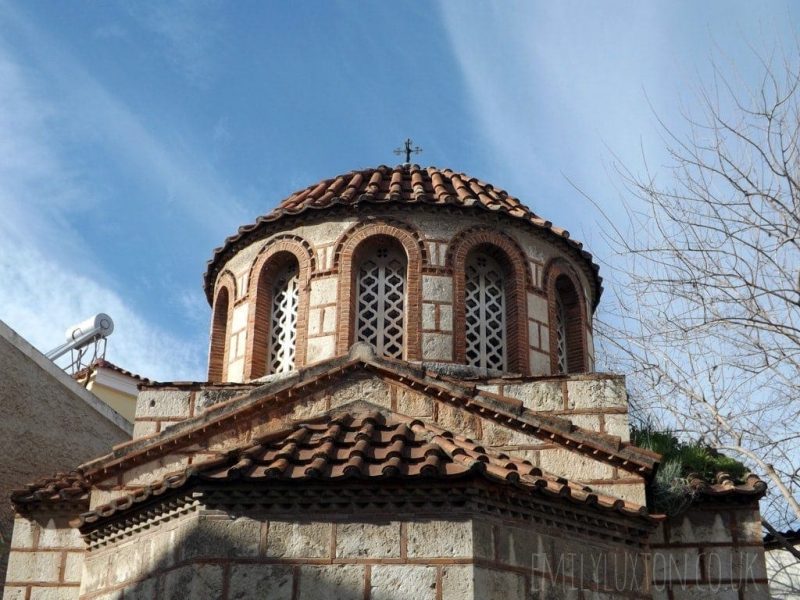
From the mid-15th century to the early 19th century, Greece was part of the Ottoman Empire, and before that was under Byzantine rule. Those centuries of occupation left as much of a mark on Athens as the earlier Ancient Romans and Greeks did.
To discover some of those traces, head to the colourful, historic district of Psirri (also called Psyri) – one of the city’s oldest neighbourhoods. A maze of winding alleyways and sloping streets designed to channel rainwater, Psirri is filled with crumbling Ottoman Mansions and Byzantine churches.
These days, it’s one of Athens’ trendiest neighbourhoods; known for its lively nightlife and great foodie scene. There’s a lot of street art around, with paintings and murals tucked into just about any available spot. Modern culture and hipster vibes blended into a beautifully antique neighbourhood – what’s not to love?
RECOMMENDED TOUR: Psyri Neighborhood Graffiti Self-Guided Game & Tour – from €10.99
13. Learn About the German Occupation at Korai 4
In more recent history, Athens was subject to another occupation: this time by the Germans during WW11. Originally an office building, Korai 4 was requisitioned as the headquarters of the Gestapo in Athens between 1941 and 1945.
Visiting Korai 4 is one of the more unusual things to do in Athens, but it’s a fascinating and chilling insight into a terrible chapter of the city’s history.
The narrow, basement-level air-raid shelter – claustrophobic behind metal air-lock doors – was converted into a “temporary” subterranean prison. Temporary in the sense that most prisoners were only kept there for a matter of days before being transported to a camp or executed.
Inside, you can see imprints of the tiny cells on the floors. The walls are scarred with writing and drawings etched by the prisoners. Some left their names and the dates of their incarceration, others scratched out doodles or self-portraits.
14. Dive Into the Trendy Gazi District
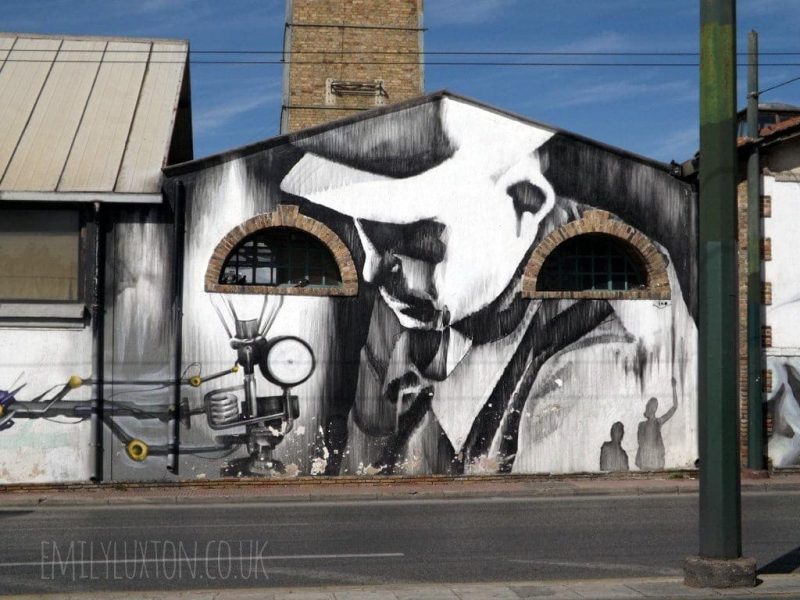
Athens is constantly reinventing itself, and nowhere is that more apparent than in the trendily grungy, industrial-chic district of Gazi.
The gas works that stood here until 1989 once pumped out so much pollution that the surrounding area was known as the “Gas District” (Gazi). Today, the now-silent chimneys and the rusted skeleton of the old gas holder still dominate the area – but now they’ve been repurposed into Athens’ coolest nightlife district.
The old gas drums have been converted into eco-friendly offices, while the former gas works now houses Technopolis, an industrial museum and a major cultural venue. The surrounding streets are packed with cafes, restaurants, bars, and clubs – including some fantastic LGBTQ+ clubs – and the neighbourhood has become known as one of the best places to party in Athens.
RECOMMENDED TOUR: Bar Crawl with Free Drinks and Club Entry – from €26.70pp
15. Take a Sip of History at the Oldest Distillery in Athens
In the heart of the historic Plata district, you can find the oldest bar and distillery in Athens: Brettos. The distillery was founded by Michail Brettos in 1909, who produced ouzo, brandy, and liqueurs based on old family recipes from Smyrni (modern-day Izmir in Turkey). You can still sample these same liqueurs today for a real taste of history!
Over a century old, this atmospheric bar still looks almost exactly as it did at the start of the 20th century. The walls behind the old wooden bar are covered with shelf upon shelf of colourful bottles, lit from behind to create a stunning effect.
RECOMMENDED TOUR: Greek Wine & Olive Oil Tasting at Brettos – 2 hours, from €110pp
16. Take an Olympic Work Out in the Historic Stadium
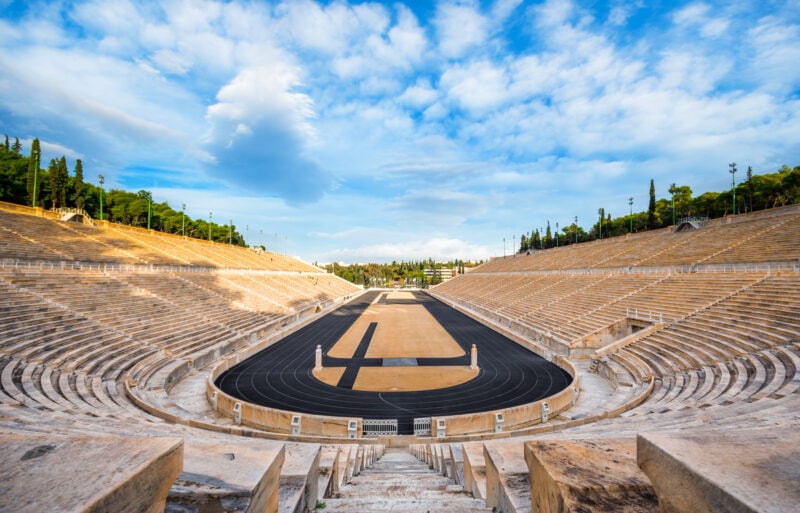
The Panathenaic Stadium is one of the most iconic sites in Athens. It was built (or re-built) as a replica of an Ancient Greek stadium which once stood on the same site and which hosted the Panathenaic Games, a religious and athletic festival celebrated every four years in honour of the goddess Athena.
The stadium we see today was reconstructed for the first modern Olympic Games in 1896. It’s also the only stadium in the world built entirely of marble.
Those looking for more unusual things to do in Athens should check out this unique Olympic Games Workout experience (from €55pp). You’ll get the chance to run around the stadium – as well as try some of the classic Olympic sports like javelin, shot put and discus.
17. Watch an Ancient Greek Theater Performance
Bring the stories and myths of Athens’ ancient buildings to life with this unique experience. In a rooftop theatre overlooking the Acropolis, you can watch a brilliant Ancient Greek Theater Show.
Actors wear traditional costumes and use masks to depict different characters, exactly as they did in ancient times. The play, ‘Medea and Other Friends I Made in Athens’, is a humorous take on the ancient Greek myths – so it’s a great way to learn a little of the history behind the city’s iconic ruins. From €25 – click here to buy tickets.
18. Or Catch a Film at an Open Air Cinema in Athens
Speaking of performances – how about an outdoor cinema? In summertime, open-air cinemas are a BIG thing in Athens, with over 60 scattered across the city. Here’s my pick of some of the best:
- Aegli – the oldest open-air cinema in the city, set within the gardens of stately Zappeion Hall.
- Cine Dexameni – on the roof of the Ancient Roman Hadrian’s Aqueduct.
- Cine Thisio – views of the illuminated Acropolis at night.
- Zefyros – historic, bohemian cinema showcasing classic & artsy films.
19. Shop with the Locals at Varvakios Market
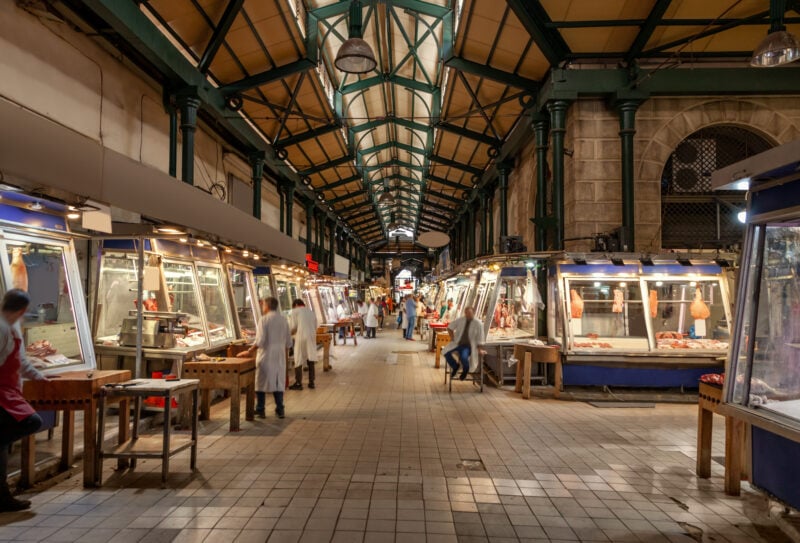
Varvakios Central Municipal Market is the biggest and liveliest market in Athens, so it’s a great place to experience an authentic side of Athenian life.
The historic building, dating from 1886, is crammed with stalls selling fresh meat, fish, olives, herbs, spices, and all manner of delicious Greek produce. It’s a great place to people-watch and sample some local flavours. Be warned, though, the sections housing the meat and fish are not for the faint-hearted!
RECOMMENDED TOUR: Half-Day Ultimate Food Walking Tour – 4 hours, from €69pp
20. Explore the Seafront of the Athens Riviera
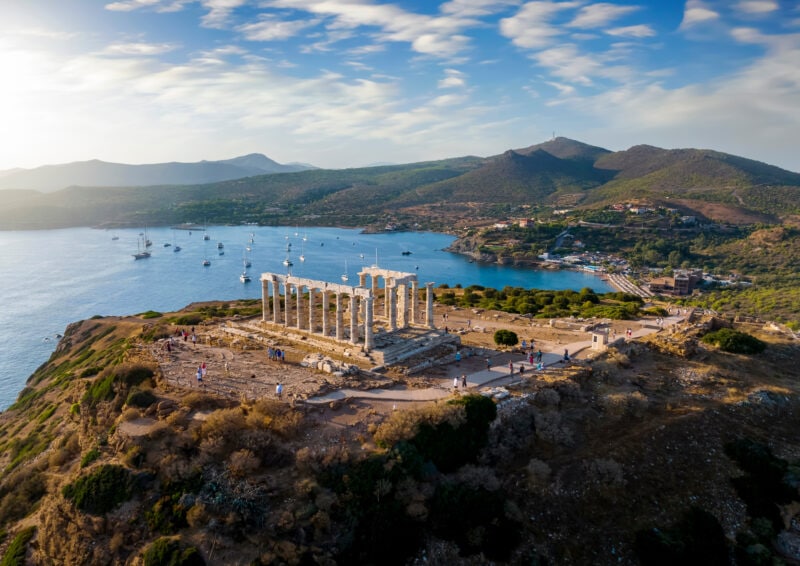
Athens may be best known as a city break destination, but you can also have a beach holiday here!
If you want to see another very different side of Athens, head south to the coastal area known as the Athens Riviera. The riviera stretches around 60km from the swanky marina at Paleo Faliro to Cape Sounion. All along it, you can find beautiful sandy beaches, bustling ports, posh “yachtie” haunts, and hidden coves.
Don’t miss the famous Temple of Poseidon, the healing mineral waters of Vouliagmeni Lake, or the excellent seafood restaurants around Piraeus.
21. Take a Greek Cooking Class
For another fun and unusual activity in Athens, consider taking a cooking class. This is a great way to meet other travellers, discover some delicious local food – and maybe learn a little about Athenian culture while you do it. Here’s my pick of the best cooking classes in Athens:
- Food Market Visit and Cooking Class with Wine – 4 hours, from €65pp
- Greek Cooking Lesson & 3-Course Dinner – 4 hours, from €98pp
- Greek Cooking Class & Dinner on a Rooftop – 4 hours, from €87pp
Unusual Things to do in Athens: Quicklist and Map
Don’t have time to read the whole post above? Here’s a quick list of the best unusual things to do in Athens – plus a handy map to help you navigate.
- Don’t Miss the Ancient Sites
- Take a Walking Tour with Alternative Athens
- Watch the Changing of the Guards at Syntagma Square
- Seek out the Street Art in Athens
- Hunt for Bargains at Monastiraki Flea Market
- Discover Athens’ Contemporary Art Scene at TAF (The Art Foundation)
- Witness Four Eras of Athens History at Monastiraki Square
- Take a Greek Food Tour in Athens
- Discover a Roman Tomb inside a Zara Store
- Swing by the Archaeological Site inside Monastiraki Metro Station
- Spot Neo-Classical Architecture on Panepistimo Street
- Spot Street Art and Ottoman Architecture in Psirri District
- Learn About the German Occupation at Korai 4
- Dive Into the Trendy Gazi District
- Take a Sip of History at the Oldest Distillery in Athens
- Take an Olympic Work Out in the Ancient Stadium
- Watch an Ancient Greek Theater Performance
- Or Catch a Film at an Open Air Cinema in Athens
- Shop with the Locals at Varvakios Market
- Explore the Seafront of the Athens Riviera
- Take a Greek Cooking Class
Read More
How to get from Piraeus cruise port to Athens
Do you know any more hidden gems or unusual things to do in Athens? Scroll down to share your top tips in the comments!

